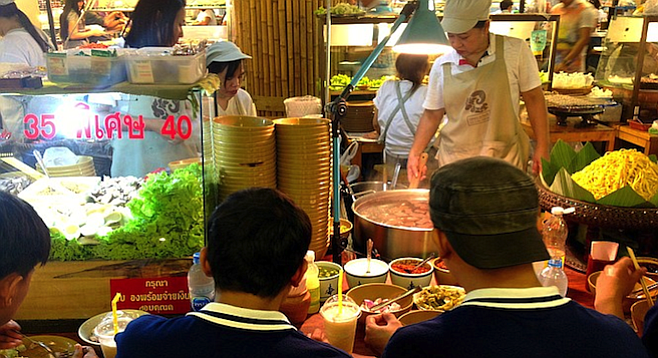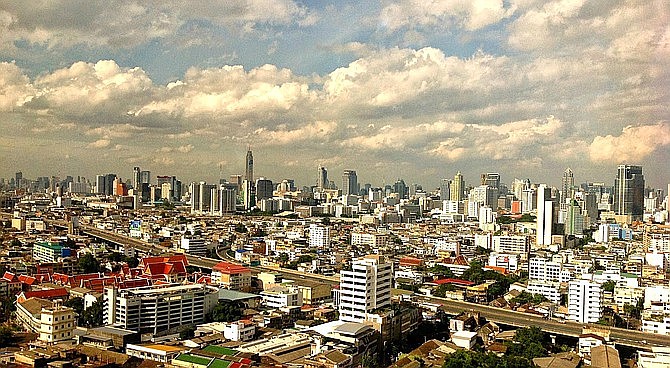 Facebook
Facebook
 X
X
 Instagram
Instagram
 TikTok
TikTok
 Youtube
Youtube

The sounds of a kitchen are like conversations.
In the beginning, you hear the fracas of so many people speaking to each other, sometimes over each other. It’s the repartee against the quick pause and response. There are the dialogues: between its concrete walls and countertops, between the cupboards and the sink, between preparation and menu. A curious soul listens in, drowning in the hum, and joins in the conversation.
I'm on a plane, crossing over the Gulf of Thailand. Mid-flight, as I drift into slumber, a voice from the cockpit interrupts my kitchen fantasy, announcing in a sing-songy Thai accent some unexpected turbulence. For a second, I think the captain’s interruption coupled with the light turbulence might be just what I needed to regain my altertness. After being airborne for hours, we’ll finally be touching down.
I have come to Bangkok on a kitchen pilgrimage. After several recent trips to explore the country’s supercharged gastronomy, I’m back – this time to find out more and take a closer glimpse at the city’s most exciting kitchens.

Because it’s a city that embraces new trends yet never loses its identity, Bangkok possesses the ideal qualities for my quest. The streets are always intoxicatingly captivating. Culinary energy is evident on every intersection and “soi,” displaying a mix of modern and ancient food preparation techniques.
I knew right away that I had to go to Yaowarat in the old Chinatown (เยาวราช). This street cuts through the heart of Bangkok’s Chinatown and is a narrow alleyway filled with makeshift carts sporting beach umbrellas colorful enough to attract visitors on their own. There are rickshaws made out of wood reinforced by welded iron bars and interestingly shrunken convertible vans that transform almost immediately into mobile kitchens.
I had to admit, regardless of their diminutive sizes, they all have the complete amenities of a kitchen run by Thai street food masters. Stoves powered by charcoal or gas, barbeque grills, woks of all sizes, chopping boards, aluminum pans and all sorts of things I could imagine in my kitchen. With humidity rising, smoke and steam, spice-scented vapors and the shouts of the street hawkers, it’s a crazy, entertaining place.
It’s a similar scene that unfolds in the sois of Sukhumvit (สุขุมวิท) and Phetchaburi (เพชรบุรี).
Here is where the flexibility of a kitchen is tested. There are free-standing kitchens that can be pushed or pulled close to the road but not too far from the gutter. Most of them are fully equipped with a tiny electric fan that serves as an exhaust or to add more fire to the wood.
Sometimes the kitchen comes with foldable tables and movable chairs. Others appear out from a hole and some emerge as an extension of a tree. As I looked at them closely and with a dose of imagination, some could rival the latest IKEA kitchen ideas. This is also the side of town where expats and locals alike succumb to the Thai street stalls and where takeout orders are common.
Getting away from the chaotic intersections and Bangkok’s neverending traffic snarls, I headed next to a more laid-back environment. Nakhon Chaisi is home to two of the oldest and most traditional markets – Ratchawat (ราชวัตร) and Sriyan (ตลาดศรีย่าน). Some secrets are revealed simply, not by asking the old auntie with a wok or the toothless man with his skewers, or the friendly motorbike driver with attached trays of fried grasshoppers and crispy maggots, but by marveling at the coordination in the series of food preparation in such confined spaces.
Drawing inspiration from all of these, I started to imagine again how my kitchen would look like. Is a small working area relative to the freshness of the food? How big or deep my wok should be or whether or not I should use a wide wooden chopping board?
In search for more answers and antithesis to what I’ve seen, I ascend to the 32nd floor of Sofitel Sukhumvit. The hotel is a short walk from Nana BTS station. I’ve heard for months about L’Appart and its open kitchen reliving the architectural style of 19th-century Paris.
Here is a intimate French restaurant bar and lounge that comes with a library, a fireplace, a balcony, and on top of it all it’s the highest kitchen location that I have visited. Glamour, style, intimacy and function; all are married here. Did I just hear the pop of a champagne bottle?
I spend an idle hour on the terrace sipping cocktails in the gentle tropical breeze, admiring the sweeping 180° panorama of Lumpini Park and the shimmering lights of downtown Silom. Waitresses walk to and fro in pastel-grey French maid’s uniforms.
Sitting on my chair, watching the lights of the business neighborhoods come on, I began to have a clearer vision of my kitchen. Somehow, I can hear the sizzle of meat hitting a searing grill, the rip of a warm crispy baguette, the crackle of ice as liquid is poured over it, the pop of a wine bottle being opened. But above all I hear a familiar voice in the background calling that dinner is ready.
A beep from my phone ebbs my imagination away. I read the text that says, “Jan…it’s mom! Have you eaten?” Then I knew above all which kitchen I should go to next.
Jan Sevilla is a quixotic nomadic chick and writer by accident with some difficulty of having her subject agree to her verb. Catch more of her travel murmurs: najsevilla.blogspot.com.


The sounds of a kitchen are like conversations.
In the beginning, you hear the fracas of so many people speaking to each other, sometimes over each other. It’s the repartee against the quick pause and response. There are the dialogues: between its concrete walls and countertops, between the cupboards and the sink, between preparation and menu. A curious soul listens in, drowning in the hum, and joins in the conversation.
I'm on a plane, crossing over the Gulf of Thailand. Mid-flight, as I drift into slumber, a voice from the cockpit interrupts my kitchen fantasy, announcing in a sing-songy Thai accent some unexpected turbulence. For a second, I think the captain’s interruption coupled with the light turbulence might be just what I needed to regain my altertness. After being airborne for hours, we’ll finally be touching down.
I have come to Bangkok on a kitchen pilgrimage. After several recent trips to explore the country’s supercharged gastronomy, I’m back – this time to find out more and take a closer glimpse at the city’s most exciting kitchens.

Because it’s a city that embraces new trends yet never loses its identity, Bangkok possesses the ideal qualities for my quest. The streets are always intoxicatingly captivating. Culinary energy is evident on every intersection and “soi,” displaying a mix of modern and ancient food preparation techniques.
I knew right away that I had to go to Yaowarat in the old Chinatown (เยาวราช). This street cuts through the heart of Bangkok’s Chinatown and is a narrow alleyway filled with makeshift carts sporting beach umbrellas colorful enough to attract visitors on their own. There are rickshaws made out of wood reinforced by welded iron bars and interestingly shrunken convertible vans that transform almost immediately into mobile kitchens.
I had to admit, regardless of their diminutive sizes, they all have the complete amenities of a kitchen run by Thai street food masters. Stoves powered by charcoal or gas, barbeque grills, woks of all sizes, chopping boards, aluminum pans and all sorts of things I could imagine in my kitchen. With humidity rising, smoke and steam, spice-scented vapors and the shouts of the street hawkers, it’s a crazy, entertaining place.
It’s a similar scene that unfolds in the sois of Sukhumvit (สุขุมวิท) and Phetchaburi (เพชรบุรี).
Here is where the flexibility of a kitchen is tested. There are free-standing kitchens that can be pushed or pulled close to the road but not too far from the gutter. Most of them are fully equipped with a tiny electric fan that serves as an exhaust or to add more fire to the wood.
Sometimes the kitchen comes with foldable tables and movable chairs. Others appear out from a hole and some emerge as an extension of a tree. As I looked at them closely and with a dose of imagination, some could rival the latest IKEA kitchen ideas. This is also the side of town where expats and locals alike succumb to the Thai street stalls and where takeout orders are common.
Getting away from the chaotic intersections and Bangkok’s neverending traffic snarls, I headed next to a more laid-back environment. Nakhon Chaisi is home to two of the oldest and most traditional markets – Ratchawat (ราชวัตร) and Sriyan (ตลาดศรีย่าน). Some secrets are revealed simply, not by asking the old auntie with a wok or the toothless man with his skewers, or the friendly motorbike driver with attached trays of fried grasshoppers and crispy maggots, but by marveling at the coordination in the series of food preparation in such confined spaces.
Drawing inspiration from all of these, I started to imagine again how my kitchen would look like. Is a small working area relative to the freshness of the food? How big or deep my wok should be or whether or not I should use a wide wooden chopping board?
In search for more answers and antithesis to what I’ve seen, I ascend to the 32nd floor of Sofitel Sukhumvit. The hotel is a short walk from Nana BTS station. I’ve heard for months about L’Appart and its open kitchen reliving the architectural style of 19th-century Paris.
Here is a intimate French restaurant bar and lounge that comes with a library, a fireplace, a balcony, and on top of it all it’s the highest kitchen location that I have visited. Glamour, style, intimacy and function; all are married here. Did I just hear the pop of a champagne bottle?
I spend an idle hour on the terrace sipping cocktails in the gentle tropical breeze, admiring the sweeping 180° panorama of Lumpini Park and the shimmering lights of downtown Silom. Waitresses walk to and fro in pastel-grey French maid’s uniforms.
Sitting on my chair, watching the lights of the business neighborhoods come on, I began to have a clearer vision of my kitchen. Somehow, I can hear the sizzle of meat hitting a searing grill, the rip of a warm crispy baguette, the crackle of ice as liquid is poured over it, the pop of a wine bottle being opened. But above all I hear a familiar voice in the background calling that dinner is ready.
A beep from my phone ebbs my imagination away. I read the text that says, “Jan…it’s mom! Have you eaten?” Then I knew above all which kitchen I should go to next.
Jan Sevilla is a quixotic nomadic chick and writer by accident with some difficulty of having her subject agree to her verb. Catch more of her travel murmurs: najsevilla.blogspot.com.
Comments